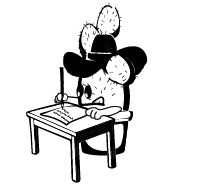In Spanish, there are twenty-seven letters in the alphabet (el alfabeto or el abecedario)—one more than in the English alphabet.The additional letter is ñ, which comes after n in alphabetized lists in Spanish. The letters k and w appear only in words borrowed from other languages. When you talk about letters in Spanish, you need to use the feminine gender (e.g., la letra a, la b, la ele, etc.).
Have a look at the table below, and listen to the audio files attached to each letter. For example, what difference do you notice in the pronunciation of the letter u? What do you notice about the pronunciation of the other vowels?
| Letters | Names of Letters | Examples | ||
| a | a | armadillo | Álamo | San Antonio |
| b | be, be larga | bota | burro | bailar |
| c | ce | caballo | cactus | casería |
| d | de | Dallas | Río Grande | disparo |
| e | e | extenso | explorar | Eldorado |
| f | efe | fábrica | flor | familia |
| g | ge | generoso | gente | General Santa Ana |
| h | hache | heno | huerto | cohete |
| i | i | iguana | independencia | Irene |
| j | jota | jaripeo | jinete | jornalero |
| k | ca (ka) | bikini | Karina | kilo |
| l | ele | Libélula | Laredo | libreta |
| m | eme | margarita | campesino | maestro |
| n | ene | Nevada | Natalia | Navarro |
| ñ | eñe | niño | ñandú | español |
| o | o | Odesa | petróleo | rodeo |
| p | pe | El Paso | pescador | patriota |
| q | cu | queso | Raquel | Quemado |
| r | erre | barril | becerro | corral |
| s | ese | Sarita | Salado | San Benito |
| t | te | Tejas | taco | tornado |
| u | u | Uvalde | único | universidad |
| v | uve, ve, or ve corta | vaca | vaquero | venado |
| w | uve doble, doble ve, or ve doble | Wildorado | Weslaco | kiwi |
| x | equis | anexar | xilofón | Extremadura |
| y | i griega or ye | yegua | Yucatán | yacaré |
| z | zeta | zoológico | zacate | corazón |
More information on the pronunciation of Spanish letters Most letters in Spanish have only one pronunciation, and thus, spelling can be said to be easier in Spanish than in English. However, there are some exceptions:
- When c appears before a, o, u and the consonants l and r, it sounds like /k/ (e.g., carismático, Costa Rica, cultura, clima, crema). When c is followed by e or i, it sounds like /s/ (e.g., centro, emocional) in Latin America, but like /th/ in some parts of Spain. When c is followed by h, it is pronounced like the ch in cheese (e.g., China).
- When g appears before a, o, u and the consonants l and r, it sounds like an English hard /g/ (e.g., arrogante, amigo, gusto, globo, gracias). When g is followed by e or i, it sounds like the English /h/ (e.g., generoso, ágil). However, if a u is between g and e or i, g is pronounced like a hard /g/, and the u is NOT pronounced (e.g., guía, espagueti). Sometimes, in the combinations gue and gui, the u is pronounced if it is marked with a diéresis (the two dots above the ü). In these cases, the g in combination with the u is pronounced /w/. Examples: bilingüe, lingüística.
- Double l (ll) is pronounced like English /y/ in yes. In some parts of Argentina and Uruguay, this sound is pronounced like /sh/ (e.g., me llamo).
- Q can only be found in the combinations que and qui. In these cases, the u is silent, and the q is pronounced /k/ (e.g., ¿qué?, quinto [fifth]). Q cannot be followed by a, o, or u (unless u is followed by e or i).
- When r is at the beginning or in the middle of a word and appears as a double r (rr), it is pronounced like a rolling r (e.g., Río Grande, Rosa, guitarra).
Let’s use these letters actively:
 ¡Manos a la obra!
¡Manos a la obra!
![]() Actividad 0-14. La reserva (The reservation).
Actividad 0-14. La reserva (The reservation).
One of the most common situations when spelling comes in handy is when we make a reservation by phone (e.g., a restaurant, a room, etc.), and we have to spell our name. Imagine that you are in this situation with a Spanish-speaking employee (empleado). The employee is asking you to spell your full name. Can you do it? Interact with a classmate, and exchange roles.
E1 (empleado): Perfecto. Para continuar la reserva, necesito (I need) su nombre. ¿Cómo se llama?
E2 (estudiante): Me llamo / Mi nombre es Sam Heughan.
E1 (empleado): ¿Cómo se escribe? (How do you spell/write it?)
E2 (estudiante): Ese-a-eme [espacio (space)] hache-e-u-ge-hache-a-ene
![]() Actividad 0-15. La Tejas hispana.
Actividad 0-15. La Tejas hispana.
Paso 1. One of the unique aspects of Texas is its Hispanic present and past. Many different places have Spanish names, and have played a role in the history of the state. The same can be said about the Hispanic community. Have a look at the following names. Do you know where they are/who they are? What is their connection to the state’s past and present? Spell these names aloud in Spanish, and google them to answer these questions. Work with two classmates. Your instructor can help you!
- San Antonio de Valero
- Misión San José
- Rancho de las Cabras
- José María de León Hernández (“Little Joe”)
- Antonio Gil Ibarvo
- El Camino Real
- El Paseo de Santa Ángela
- Casa Navarro
- Misión del Espíritu Santo
- Segundo Barrio
Paso 2. What other names do you guys know? Find five more Spanish names that are important in Texas or your state’s past/present. Spell the names and be ready to tell the class more about the names you’ve found.
Click on the following button to continue applying what you learned about the alphabet.
Now it’s time to learn about the diversity of the Spanish-speaking world:


